Pancake Mix
Copied someone else's pancake recipe
Yes, I'm talking about that inherent "3DSness" when you look at a screenshot.
First a disclaimer: Yes, I know that different artists create very different-looking games on the same hardware, I understand that. I'm speaking more to common traits across games, right down to obviously a shared resolution but also to an extent their look, polygon density, texture quality, those good old PS1 or blown up 3DS screen jaggies, lighting techniques, etc.
This may be subjective, but in my eyes I saw old console games had their own distinct look based on the hardware, a look that carried between games due to the console's limitations. This became extremely apparent in the 5th gen when PS1's lack of a z-buffer, Saturn's lack of a z-buffer and unique rendering techniques, and N64's different limitations (tiny texture cache, lack of a dedicated sound chip, and limited game storage for starters) gave every game very distinct looks. N64, released later, thankfully had a z-buffer and games could often have huge worlds that the PS1 did not early on. Spyro almost seemed like a proof of concept in that regard, and even then, it looked distinct from N64's work of smooth (perhaps even too smooth) areas created with limited numbers of polygons and a limited texture cache. PS1 textures appeared pixelated, while N64 textures were often compressed and stretched across vast surfaces. Many PS1 games used pre-rendered backgrounds to display a detailed 3D environment, most prominently the Resident Evil and Final Fantasy titles. The technique was rarely used on N64, but perhaps most prominently in its port of Resident Evil 2, which neccesitated many image artifacts to reduce a 2 CD game down to a 64 MB cartridge.
At the very least I'm trying to get games in a similar genre at or very close to their native resolution. All three consoles had multiple render modes, but 320x240 and 320x244 were common.
Additionally, virtually every N64 game had anti-aliasing, though Quake 64 allowed you to turn it off. This helped smooth out jaggies and dithering, but it also created something of a Vaseline filter on the image.
About a million examples can be shown with different showpieces like Wave Race 64, the aforementioned Spyro for PS1, and Nights...Into Dreams for the Sega Saturn, but I wanted to get right to the 3DS.
Correct me if I'm wrong, but it appears that technically the 3DS has to render twice for each eye in 3D mode, leading to a 800x240 resolution. Regardless it is 400x240 for each eye and in 2D mode. So these screens are in the otherwise native rendering resolution of 400x240 with the top screen's unusual 5:3 ratio:
Resident Evil: Revelations (2012)

The Legend of Zelda: Majora's Mask 3D (2015)


Xenoblade Chronicles 3D (2015, New 3DS only)


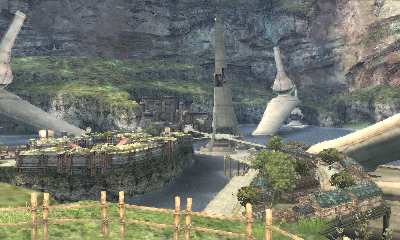
I'm aware I used two ports here, but Majora's Mask 3D used loads of new textures and geometry to meet modern standards while Xenoblade Chronicles 3D had to reduce texture quality in places to run.
Revelations is the obvious standout on the OG 3DS graphically, but these 3DS games all seem to have a certain look due to the limitations of the device that you don't seem to find in more modern, PC-like consoles. Xenoblade Chronicles X looks fantastic, for example, but I could have seen it running as a very high-end PS3 or 360 game, whether or not that'd be possible with the lower amount of total RAM (albeit clocked higher) but stronger CPU. Even with the different limitations of those platforms, games seemed to scale quite well at that point. I feel there is some weird form of diminishing returns where we are effectively seeing diminishing limitations causing games released on different platforms to lose their distinct look. Exclusives are very important for Sony and Nintendo's business, but the limitations of the hardware they're on no longer seems to colour the game's progression, just look at Breath of the Wild, which looks like it could also have worked on last gen's HD twins as well as scaled up as a cross-gen game in my eyes. Fantastic looking game, but of a new era where platform limitations no longer give every game (or nearly every game) on that platform a distinct look.
What say you, GAF?
First a disclaimer: Yes, I know that different artists create very different-looking games on the same hardware, I understand that. I'm speaking more to common traits across games, right down to obviously a shared resolution but also to an extent their look, polygon density, texture quality, those good old PS1 or blown up 3DS screen jaggies, lighting techniques, etc.
This may be subjective, but in my eyes I saw old console games had their own distinct look based on the hardware, a look that carried between games due to the console's limitations. This became extremely apparent in the 5th gen when PS1's lack of a z-buffer, Saturn's lack of a z-buffer and unique rendering techniques, and N64's different limitations (tiny texture cache, lack of a dedicated sound chip, and limited game storage for starters) gave every game very distinct looks. N64, released later, thankfully had a z-buffer and games could often have huge worlds that the PS1 did not early on. Spyro almost seemed like a proof of concept in that regard, and even then, it looked distinct from N64's work of smooth (perhaps even too smooth) areas created with limited numbers of polygons and a limited texture cache. PS1 textures appeared pixelated, while N64 textures were often compressed and stretched across vast surfaces. Many PS1 games used pre-rendered backgrounds to display a detailed 3D environment, most prominently the Resident Evil and Final Fantasy titles. The technique was rarely used on N64, but perhaps most prominently in its port of Resident Evil 2, which neccesitated many image artifacts to reduce a 2 CD game down to a 64 MB cartridge.
At the very least I'm trying to get games in a similar genre at or very close to their native resolution. All three consoles had multiple render modes, but 320x240 and 320x244 were common.
Additionally, virtually every N64 game had anti-aliasing, though Quake 64 allowed you to turn it off. This helped smooth out jaggies and dithering, but it also created something of a Vaseline filter on the image.
Final Fantasy VII (PS1, 1997)
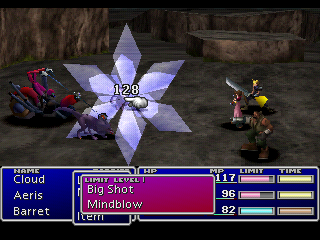

Quest 64 (N64, 1998)
Hardware:
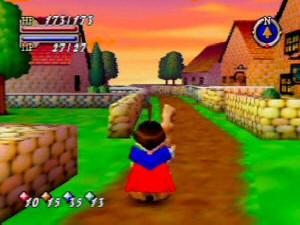
Emulated:
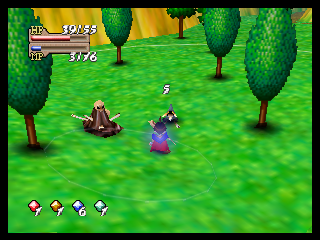
Panzer Dragoon Saga (Saturn, 1998):
Seemingly hardware:
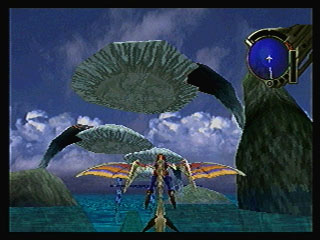
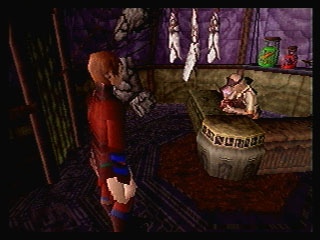
About a million examples can be shown with different showpieces like Wave Race 64, the aforementioned Spyro for PS1, and Nights...Into Dreams for the Sega Saturn, but I wanted to get right to the 3DS.
Correct me if I'm wrong, but it appears that technically the 3DS has to render twice for each eye in 3D mode, leading to a 800x240 resolution. Regardless it is 400x240 for each eye and in 2D mode. So these screens are in the otherwise native rendering resolution of 400x240 with the top screen's unusual 5:3 ratio:
Resident Evil: Revelations (2012)

The Legend of Zelda: Majora's Mask 3D (2015)


Xenoblade Chronicles 3D (2015, New 3DS only)



I'm aware I used two ports here, but Majora's Mask 3D used loads of new textures and geometry to meet modern standards while Xenoblade Chronicles 3D had to reduce texture quality in places to run.
Revelations is the obvious standout on the OG 3DS graphically, but these 3DS games all seem to have a certain look due to the limitations of the device that you don't seem to find in more modern, PC-like consoles. Xenoblade Chronicles X looks fantastic, for example, but I could have seen it running as a very high-end PS3 or 360 game, whether or not that'd be possible with the lower amount of total RAM (albeit clocked higher) but stronger CPU. Even with the different limitations of those platforms, games seemed to scale quite well at that point. I feel there is some weird form of diminishing returns where we are effectively seeing diminishing limitations causing games released on different platforms to lose their distinct look. Exclusives are very important for Sony and Nintendo's business, but the limitations of the hardware they're on no longer seems to colour the game's progression, just look at Breath of the Wild, which looks like it could also have worked on last gen's HD twins as well as scaled up as a cross-gen game in my eyes. Fantastic looking game, but of a new era where platform limitations no longer give every game (or nearly every game) on that platform a distinct look.
What say you, GAF?


